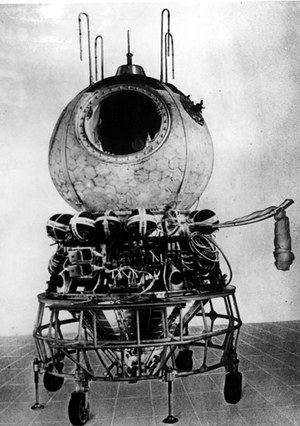Vostok: an aerospace classicby Andrew J. LePage
|
| Despite the change in focus of the manned space program, the Vostok design was never really abandoned but continued to be improved and adapted for a wide variety of military, scientific, and commercial missions over the decades to come. |
The impact of the first human spaceflight can hardly be appreciated today. The flight of Yuri Gagarin was followed by five more successful flights of the Vostok-3KA spacecraft over the next two years. Afterwards, the 3KA was modified into the 3KV, which could carry up to three cosmonauts into orbit. The first crewed mission was flown on October 12, 1964, as Voskhod 1 for the first multi-person spaceflight. A deployable airlock was added to the 3KV to allow the first EVA to be performed by Alexei Leonov on March 18, 1965, during the mission of Voskhod 2. A long-duration Voskhod mission had been considered, but only the 21-day unmanned test flight of Kosmos 110 with two canine test subjects on board was launched on February 22, 1966. With the focus of manned Soviet spaceflight turning towards the Soyuz program, no more manned spaceflights using the Vostok design were ever flown.
Despite the change in focus of the manned space program, the Vostok design was never really abandoned but continued to be improved and adapted for a wide variety of military, scientific, and commercial missions over the decades to come. Including the man-related space missions of the Vostok and Voskhod series, the Vostok design has been flown over 800 times during the course of half a century, easily making it the most flown recoverable spacecraft design.
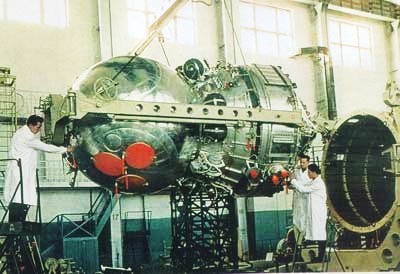 A Zenit-2 being prepared for launch. (credit: RKK Energia) |
Origins of Vostok
Like most other Soviet spacecraft during the early years of the Space Age, the design of Vostok and its descendants originated in OKB-1 (the Russian acronym for Experimental Design Bureau - 1) headed by the famed Russian aerospace engineer Sergei Korolev. By 1958 a team of engineers under the direction of Konstantin P. Feoktistov in Project Department No. 9 of OKB-1 had developed the basic Vostok design. Vostok was a two-module spacecraft composed of a spherical descent module and a service module. The descent module was a sphere 2.3 meters (7.5 feet) in diameter weighing about 2,400 kilograms (5,300 pounds). This module carried the cosmonaut during his mission and provided all the equipment needed to safely return him to Earth.
There were many advantages to a spherical descent module. First, the aerodynamics of a sphere were well understood and it promised to be stable. This shape also maximized the interior volume for the passenger and critical recovery systems while at the same time minimizing the mass required for the structure and heat shielding. By offsetting its center of mass from its center of figure, the reentry module would automatically keep itself oriented during its return to Earth without the weight penalty of an active attitude control system. This approach did result in a more punishing ballistic reentry but peak braking loads would still be limited to a tolerable 10 Gs.
The service module carried all the equipment not needed for the return to Earth. It was a double cone shape about 2.4 meters (7.9 feet) in diameter and about as tall with a mass of 2,300 kilograms (5,100 pounds). It was connected to the descent module by straps and an umbilical arm designed to burn away in case they failed to separate before reentry. This module carried various consumables for life support, the attitude control system, batteries, telemetry systems, and a liquid propellant TDU-1 retrorocket at its base. Producing 16 kilonewtons (3,600 pounds-force) of thrust for 45 seconds, the TDU-1 was built by OKB-2 under Alexei M. Isayev. Spacecraft attitude was controlled automatically by gas jets using inputs from solar and infrared sensors. The underside of the service module was covered with radiators to remove waste heat generated by the spacecraft systems. The interior of the service module, like the descent module, was pressurized to provide a laboratory-like environment for the onboard equipment to simplify equipment design and thermal control.
| There were many advantages to a spherical descent module. |
Even as work progressed on the Soviet manned spacecraft, a major debate continued with military interests inside the Soviet government. In an effort to broaden the appeal for the manned space program, Korolev's engineers also designed a photographic reconnaissance variant of the Vostok spacecraft. To this end, three versions of the design were envisioned: the Vostok-1K was a prototype that tested the basic systems common to both designs. Its first flight, a non-recoverable test article designated 1KP, was Korabl Sputnik 1 launched on May 15, 1960. The manned version, called Vostok-3KA, made its first test flight on March 9, 1961, as Korabl Sputnik 4. The successful, unmanned dress rehearsal of Korabl Sputnik 5 on March 25 set the stage for the successful flight of Yuri Gagarin 18 days later.
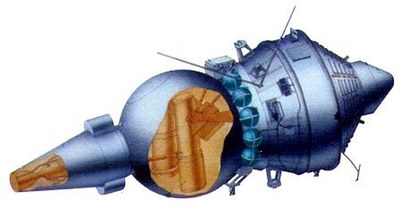 A cutaway view of a Zenit-6U reconnaissance satellite. Note the maneuvering engine housed in the small module on the left. (credit: TsSKB-Progress) |
The Zenit spacecraft
The third version of the Vostok was eventually known as the Zenit-2. Its mission was to perform a week-long, wide-area survey at moderate resolution over the United States and other areas of interest around the world, broadly similar to the early American Corona reconnaissance satellites of that era. In this role, all of the systems in the Vostok associated with supporting a pilot were removed and replaced with a payload of cameras and other reconnaissance gear. The descent module would return not only the exposed photographic film but the entire camera system for potential reuse. In order to carry additional support equipment required for its entirely automated mission, the service module of the Zenit-2 was lengthened by about half a meter (a foot and a half) by the addition of a cylindrical belt between the two conical halves of the service module. The Zenit-2 had a total mass of around 4,720 kilograms (10,400 pounds) and was initially launched using the 8K72K Vostok rocket and improved versions like the 8A92 as they became available later.
The first Zenit-2 to successfully make it into orbit was Kosmos 4 launched on April 26, 1962. Not only was this the first Soviet reconnaissance mission, it was also the first non-science mission to conceal itself inside the Kosmos series (see “Lies, damned lies, and cover stories”, The Space Review, November 20, 2006). In March of 1964 the Zenit-2 was officially accepted into military service. By this time further production and development of the Zenit had been transferred to OKB-1 Branch 3 managed by Dmitri I. Kozlov. In 1974 this branch was spun off as the independent TsSKB or Central Specialized Design Bureau.
By 1968 the Zenit-2 began to be phased out, with its last launch, the 81st, coming on May 12, 1970, for the mission of Kosmos 344. A modernized version, the Zenit-2M, capable of 12-day missions, replaced the Zenit-2 in its role of making wide-area surveys. The Zenit-2M made 101 flights with its last launch coming on August 17, 1979, with the mission of Kosmos 1122.
| While the Zenit design had the advantage of being simple and robust, its limitations in the reconnaissance role led to the development of a totally new design called Yantar. |
Starting in 1969, some of the Zenit-2 and -2M missions carried an additional module on top of the descent module called a “nauka” or science module. While it was common for the Zenit to carry supplemental payloads or even launch small sub-satellites, this new module allowed larger, non-recoverable payloads or other equipment to be carried into orbit. Over the years to come, this arrangement allowed for more flexibility in the design of subsequent Zenit variants.
While the Zenit-2 series provided images with a resolution reported to be on the order of 10 to 15 meters (33 to 50 feet), a system capable of acquiring higher resolution images was required. The Zenit-4, introduced with the launch of Kosmos 22 on November 16, 1963, provided a close-look capability by replacing the original Zenit-2 camera package with a more capable design. With the additional equipment it carried, the Zenit-4 mass had increased to about 6,300 kilograms (13,900 pounds) and now required the larger Voskhod launch vehicle (and later, the improved Soyuz) to get into orbit. Like the Zenit-2, the Zenit-4 began to be phased out in 1968 and was launched for the last time on August 7, 1970, for the Kosmos 355 mission.
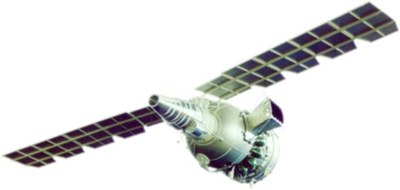 A view of the Resurs-F2 with its solar panels deployed. (credit: TsSKB-Progress) |
Just like its sister, the Zenit-4 was upgraded to produce the Zenit-4M, which made its maiden flight on October 31, 1968, as Kosmos 251. In order to improve the flexibility of the Zenit-4M, the new version carried a third module mounted on top of the descent module that was equipped with a supplemental propulsion system. This system allowed the Zenit-4M and its descendants to be maneuvered so that the orbit would carry its high-resolution cameras over a target of interest. This capability also allowed the Zenit-4M to maintain its low orbit (which was ideal for high resolution photography) during its two-week-long mission. This supplemental system was required since the propulsion system carried in the service module was designed for only a single use: to deorbit the Zenit at the end of its mission.
The Zenit-4M was further modified to become the 4MK, which was introduced in 1969, and finally the Zenit-4MKM, which came into service in 1977. The last Zenit-4 close-look reconnaissance mission was launched on October 10, 1980, as Kosmos 1214. A total of 256 flights of the various high-resolution variants of the Zenit-4 were launched during its 17 years of service.
While the Zenit design had the advantage of being simple and robust, its limitations in the reconnaissance role led to the development of a totally new design called Yantar. But just as with many other advanced spacecraft, its development took much longer than originally anticipated and did not officially become operational until 1978. As a stopgap measure, another Zenit model was introduced in 1976: the Zenit-6U, where the “U” stood for “universal”. The intent was to create a single, universal reconnaissance satellite design that could be equipped with various camera payloads to carry out wide area surveys (like the Zenit-2 series) or close-look missions (like the Zenit-4 series). Like the Zenit-4M and subsequent models, the Zenit-6U carried a supplemental propulsion system to allow the satellite to maneuver during its two-week mission.
A total of 95 Zenit-6U missions were flown until the Zenit design was finally phased out for reconnaissance missions in favor of the new Yantar satellites. The last mission flown was Kosmos 1573 launched on June 19, 1984—over 22 years after the introduction of the first Zenit.
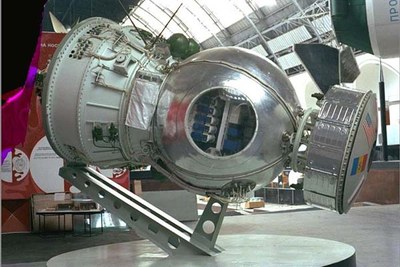 A model of the Zenit-derived Bion spacecraft. (credit: NASA) |
More missions for Zenit
While the Zenit spacecraft provided imagery for various intelligence purposes, there was also a need for precision maps of various areas of interests around the world. In 1971 the Zenit-4MT, also known as Orion, was introduced specifically to generate high-precision cartographic photographs suitable for mapmaking. A total of 23 Orion missions were launched, with the last, Kosmos 1398, orbited on August 3, 1982. With the continued delays in the development of the Soviet military’s new Yantar-1KF mapping satellite, the improved Zenit-8, also known as Oblik, was introduced with the launch of Kosmos 1571 on June 11, 1984. A total of 101 Oblik missions were launched ending with the flight of Kosmos 2281 launched on June 7, 1994—32 years after the introduction of the Zenit series.
In 1975 yet another Zenit variant, the Zenit-4MKT or Fram, was introduced. The Fram spacecraft carried a suite of multispectral photographic cameras designed specifically for remote sensing applications such as the search for natural resources, monitoring land use and the like. A total of 27 Fram missions were flown, ending with the flight of Kosmos 1681 launched on September 6, 1985.
| More flights of the improved Bion-M and Foton-M are planned for 2012 and 2013, respectively, keeping the basic Vostok/Zenit design flying over half of a century after its introduction. |
Even after the new Yantar reconnaissance satellites began to fly, development of the series’ cartographic model continued to fall behind schedule and increase in cost. In order to get the program back on track, the cone-shaped Yantar descent module was abandoned in favor of a spherical Zenit descent module to produce a hybrid design known as the Yantar-1KFT or Kometa. The adoption of the flight-proven Zenit descent module for Kometa maximized the internal volume for its cameras and control equipment while minimizing the total spacecraft mass. The Yantar-1KFT made its first test flight as Kosmos 1246 launched on February 18, 1981. The Kometa became operational with the launch of Kosmos 1896 on November 14, 1987. The series continues to fly, albeit much less frequently in the last dozen years, with the 21st flight launched on September 2, 2005.
While the cartographic and remote sensing data acquired by Orion, Oblik, and Fram, as well as the Zenit-2M, had military applications, it was recognized that they had a multitude of obvious civilian uses as well. Several of these Zenit missions were flown with primarily civilian objectives as part of the Soviet’s Resurs program. With the Zenit being phased out for military reconnaissance missions during the early 1980s after the introduction of the Yantar, the Zenit design was adopted for a range of purely civilian missions.
The first dedicated series of civilian remote sensing satellites was the Resurs-F1. Three variants of the Resurs-F1 were built carrying different suites of cameras and other equipment into orbit for two-week missions. The first flight, Kosmos 1127, was launched on September 5, 1979. On May 25, 1989, Resurs F-1 was launched to become the first in the series to be assigned the “Resurs F” name openly. The last of the Resurs-F1 variants to be launched, Resurs F-19, reached orbit on August 24, 1993. After the disintegration of the Soviet Union in 1991, the high-quality photographs from Resurs began to be sold commercially. Two additional flights of a modified Resurs-F1M design were made in 1997 and 1999, bringing the total of Resurs-F1 flights to 56.
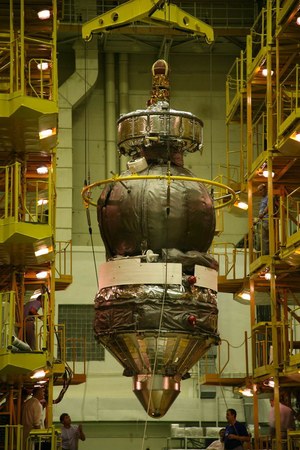 The most recent Zenit-variant, Foton M-3, being prepared for its launch on September 14, 2007. (credit: TsSKB-Progress) |
A second series of remote sensing satellites based on the Zenit-4M was the Resurs-F2. It carried a suite of multispectral photographic cameras on missions lasting up to 30 days. The supplemental module on the top of the Resurs-F2 was fitted with solar panels to keep the spacecraft’s batteries charged during the longer mission. Kosmos 1906 launched on December 26, 1987 was the first Resurs-F2 orbited. The last Resurs-F2 mission, which brought the total to 11 missions, was Resurs F-20 launched on September 26, 1995 (the Russian did not differentiate between the various Resurs-F versions in their assignments of ”Resurs F” mission names). As with the photographs from the Resurs-F1 series, the Resurs-F2 data were also sold commercially starting in the early 1990s. While the quality of the data was quite high, in the end photographic remote sensing has been phased out in favor of digital data products like that produced for years by satellites such as LANDSAT or Spot.
Long before the Resurs-F series flew, other civilian applications were found for the Zenit design. On April 7, 1972, the Interkosmos 6 mission was launched on a four-day flight. It used a Zenit spacecraft to carry recoverable cosmic ray and micrometeoroid detectors as part of the Energia program. A second launch, Kosmos 1026, took place on July 2, 1978. Two similar missions as part of the Efir program were launched as Kosmos 1543 and 1713 in 1984 and 1985, respectively.
Harkening back to its Vostok roots, the Zenit design was modified to carry recoverable biological experiments into orbit as part of the long-running Bion series. The first, Kosmos 605, was launched on a three-week mission on October 31, 1973. The eleventh mission in the series was launched on Christmas Eve 1996. Another Zenit variant, called Foton, was designed to perform microgravity material science investigations during a two-week long mission. The first in the series was Kosmos 1645 launched on April 16, 1985. After the fall of the Soviet Union, great efforts were made throughout the 1990s to sell space on the Foton missions as part of a commercial venture. The upgraded Foton-M was first successfully launched on May 31, 2005. The fifteenth Foton launch, Foton M-3, occurred on September 14, 2007.
During the 1990s TsSKB proposed that the Zenit-based civilian versions of spacecraft be phased out in favor of the much larger and more capable Nika then under development. Like the Kometa, the Nika series would combine the Zenit’s spherical descent module with a more advanced Yantar-derived service module for flight times of one to three months depending on the mission. In the end the Nika proposals did not go far because of their greater expense and the need for a larger launch vehicle instead of the more readily available Soyuz. Instead, upgraded versions of the proven Zenit design continued to be flown through the first decade of the 21st Century. More flights of the improved Bion-M and Foton-M are planned for 2012 and 2013, respectively, keeping the basic Vostok/Zenit design flying over half of a century after its introduction. Few spacecraft designs have had this kind of longevity.
Bibliography
Phillip Clark, The Soviet Manned Space Program, Orion Books, 1988
Phillip S. Clark, “Classes of Soviet/Russian Photoreconnaissance Satellites”, Journal of the British Interplanetary Society, Vol. 54., No. 9/10, pp. 344–360, September/October 2001
Rex Hall and David J. Shayler, The Rocket Men: Vostok & Voskhod, The First Soviet Manned Spaceflights, Springer-Praxis, 2001
D.I. Kozlov, Konstruirobanie Avtomatisheskiya Kosmisheskiya Apparatov (in Russian), Mashinstroenie, 1996
